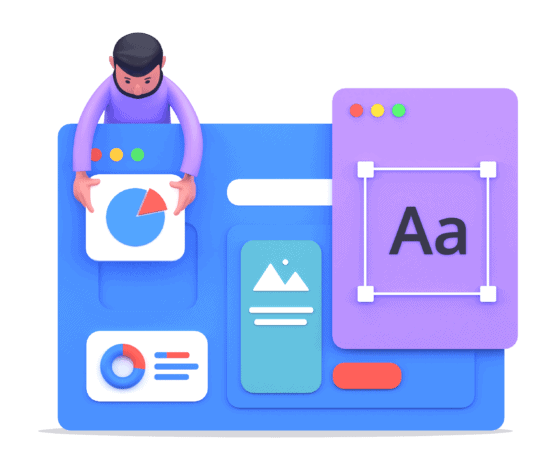
The core goal or purpose of web design is to create a website that effectively captures what its users are looking for. Get that right, and you can provide a seamless and intuitive experience that ultimately results in them taking the next step.
To achieve this, designers need to strike the right balance between three main elements:
- Aesthetics
- Usability
- Functionality
A well-designed website will be visually appealing and easy to navigate, ultimately guiding users towards the desired action with as few obstacles and distractions as possible.
Understanding the goals of web design helps businesses create websites that cater to their audience’s needs and preferences.
In the design process, multiple aspects are considered as part of a winning formula, including:
- Content Strategy
- Visual Details
- Accessibility
- User Experience
Using their knowledge and experience, your design team will help you create a business website that won’t just attract users but will keep them engaged and coming back for more.
Key Takeaways
- A well-designed website balances aesthetics, usability and functionality to meet user expectations.
- Web design focuses on creating a seamless experience that gently guides users towards a desired outcome.
- Attention to detail, content strategy and accessibility are vital aspects of successful web design that create an engaging user experience.
Table of Contents
Understanding Web Design
Web design is the art of planning, conceptualising and arranging content on a website that provides potential users with quality accessibility and functionality.
Its primary goal is to create an aesthetically pleasing and user-friendly interface that caters to users seeking information, browsing or purchasing your products and services.
While a graphic or creative web designer is skilled, the web designer you choose for your business website must understand the code behind the screen.
Designers need to comprehensively understand how a website works and the functionality of its various components. This includes organising content and images across multiple pages and integrating applications and other interactive elements, such as buttons, forms and multimedia.
Elements of Web Design
There are several essential elements of web design to consider. While it’s important to pay attention to visual details, including colour, layout, typography and imagery, others may not be as evident as they take place behind the scenes but are still crucial in achieving your website’s purpose.
Colour
Colour choice can set the tone and mood and help establish brand identity, and evoke specific emotions. Colour schemes must be consistent across the entire website and tailored to the target audience’s preferences. A quality website designer will use highly contrasting colours to make the text more readable and create a visual hierarchy, allowing users to navigate the site more easily.
Imagery
Images and multimedia should be strategically placed to enhance user engagement and convey information effectively. High-quality imagery immediately captures users’ attention and reinforces your message or theme. Don’t choose stock images if you can help it. Instead, choose images that are:
- Personal and relevant to your business.
- Have high image quality
- Are consistent with your overall branding
Using negative or “white space” around images can enhance the website’s visual appeal and ensure its content is easily digestible.
Layout
A well-thought-out layout is crucial for guiding users through the website, helping them find what they are looking for efficiently and seamlessly. Assisting visitors to reach their goals easily is a big bonus as it cuts overwhelm and increases trust. Users who feel overwhelmed or can’t find what they want will exit and look elsewhere. If this happens with many of your visitors, you will get a high bounce rate, making it harder for you to be seen in organic search results.
Responsive Design
Web design also encompasses responsive design, ensuring a website displays and functions optimally on various devices and screen sizes. This has become increasingly important as more users access the internet from smartphones and tablets. As well as differences in screen sizes, you need to consider touch screens, typography, text sizes, menu locations and page orientation.
Typography
Selecting suitable font types, sizes, and styles can significantly impact the website’s aesthetic and readability. Opt for easily legible fonts complementing the website’s content and design elements. Hierarchy, alignment, and text spacing can also be used effectively to ensure content is organised and easy to navigate.
Optimisation
Web designers must consider website performance and optimisation. This includes ensuring fast loading times, improving search engine visibility and facilitating easy user navigation. These are essential for increasing user satisfaction and trust in your brand, but they also come back to doing what you can to improve your website search engine rankings in organic search returns.

Goals of Web Design
The core goal of web design is to create a user-friendly and visually appealing website that effectively communicates a brand’s message and achieves your desired objectives. The scope of these objectives will vary widely, depending on the nature of each website, so rather than a cut-and-paste solution, talk to your web design team about what you want to achieve so they can tailor a website that points towards all your targets.
There are several common goals I see across all websites and will discuss with you to achieve:
Attract and Engage Users
First and foremost, a primary objective of web design is to attract and engage users. The website’s layout, visual elements and overall aesthetics are crucial in capturing visitors’ attention and maintaining their interest.
A well-designed website can help create a positive first impression and establish trust and credibility for the brand.
Facilitate User Navigation and Information-Seeking
Your website designer will work to ensure your users can quickly and effortlessly locate the information they’re searching for. Clear navigation, intuitive user interfaces and concise, relevant content are essential aspects that contribute to effective information-gathering. It adds value when you consider a visitor’s time and effort and have steps in place to get them from A to B or A to Z smoothly.
As ironic as it seems, helping users achieve their goals quickly will encourage them to spend more time on your website.
Conversions
Conversions are vital to web design, especially for business or eCommerce websites. Web designers must create an experience that anticipates user pathways and encourages users to take desired actions. Not every business will be looking for conversions – and not every visitor will be ready to buy – which is why some flexibility can be applied to expand conversions to include making a purchase, signing up for a newsletter, joining a community group, asking about a service, downloading resources or booking an event or webinar.
Implementing clear calls to action, user-friendly forms, and well-structured pathways can assist in achieving higher conversion rates.
Mobile Devices
A successful web design should be adaptable and scalable to accommodate various devices, browsers, and screen sizes. This means employing responsive design techniques to ensure the website performs effectively on mobile devices and desktop computers.
By doing so, your website remains accessible to a broader range of users, increasing your chance of success.
We build stunning, user-focused websites that will wow your customers.
Are you a business owner in Singapore, Australia or worldwide? We work with clients across the globe to deliver beautiful yet functional website designs.

The User Experience
The core goal of web design is to enhance user experience. At the centre of this objective lies prioritising functionality, ensuring that users can easily interact with the website and its features. Each element of a web page should serve a purpose and meet the users’ needs, helping them complete their tasks efficiently.
This includes a well-structured menu bar, informative links, and a coherent site layout.
Don’t look to reinvent the wheel. A tried and true website format provides a sense of familiarity for users, making it easier for them to navigate and engage with the website. Continuous and consistent design elements will help reinforce your brand identity and enhance usability when adding flare and colour.

How Important is Content Strategy?
Content strategy is vital in web design as it helps ensure the website’s information is meaningful, cohesive, engaging, and sustainable. Ultimately, your content will give your online business personality and incredible value to those visiting your website.
What is Content Strategy?
A content strategy is your plan to create and publish content and how that content will evolve over time. It can include the topics and values you cover, a schedule for release and supporting documents and promotions – including social media – that link back to your main article and pages.
By focusing on your user’s needs and wants, content strategy strives to provide a positive experience for the audience while simultaneously achieving specific business goals.
Content and SEO
One of the primary objectives of a content strategy is to improve your search engine optimisation (SEO) results. SEO influences your website’s visibility and ranking in search engine results, giving you more access to new quality leads. By creating quality and relevant content and optimising it through proper keyword selection and placement, web designers can drive organic traffic to a blog or website.
Your content strategy will also aim to close any content gaps. A typical page generated for this purpose is Frequently Asked Questions. By conducting a content audit and identifying existing gaps within the website, you can create better content that targets the right audience and fills those gaps, boosting your value and brand authority.
How you deliver your content is entirely up to you. Consider what format of content will suit your brand and audience. This may include blog posts, articles or multimedia formats such as videos and interactive graphics or a mix of different methods structured in your schedule – just be confident with how you present so that you can resonate with your readers, leading them to spend more time on the site and increasing the likelihood that they’ll share the content or convert.
The Conversion Goal
No matter what else your website does, the core goal or purpose of web design is to encourage website visitors to take a specific action, known as a conversion.
Conversions may include purchasing, signing up for a newsletter or filling out a form.
To achieve these goals, web designers employ various techniques, such as using effective calls to action (CTAs) and optimising the site for high conversion rates.
Call to Action Usage
A crucial element that dramatically impacts conversions is the strategic placement and usage of CTAs. CTAs are typically buttons or links encouraging users to take the desired action, such as “Buy Now” or “Sign Up”. These should be clear, visually appealing and easy to find on a web page. By ensuring that users can quickly identify and act upon CTAs, a web designer increases the likelihood of achieving the website’s conversion goals. Moreover, the choice of language, colour and design must effectively draw attention and persuade users to take the desired action.
Have a primary and secondary CTA set up so visitors who need more details can easily click deeper into your site, while those ready to take the next step can move to the end goal.
Conversion Rate Optimisation
Conversion Rate Optimisation (CRO) focuses on fine-tuning the website design to maximise the percentage of visitors who complete the desired action. A well-optimised site ensures that layout, navigation, and content are tailored to guide users towards the intended conversion goal. Web designers use testing, data analysis, and user feedback to make decisions on design adjustments that will lead to better conversion rates.
CRO may involve the following:
- Simplifying navigation: Making it easy for users to access essential pages and find CTAs.
- Improving page speed: Ensuring the site loads quickly to reduce the chance of users abandoning due to slow performance.
- A/B testing: Comparing the effectiveness of two or more different design elements to determine which performs better in achieving conversion goals.
- Tailored content: Present relevant and engaging content that meets the needs and interests of the target audience.
By focusing on achieving conversion goals through the strategic use of CTAs and a dedicated approach to CRO, web designers ensure that a website serves its primary purpose effectively.

Accessibility in Web Design
People with disabilities, such as visual, auditory, cognitive, physical, neurological or speech, rely on different tools and technologies to interact with the web. By incorporating accessibility principles into web design, developers can cater to a broader audience and remove barriers to communication and interaction.
To achieve accessibility in web design, designers can consider following specific guidelines, such as the Web Content Accessibility Guidelines (WCAG) provided by the World Wide Web Consortium (W3C). These guidelines provide a set of recommendations for creating accessible websites that cater to different disabilities. Some of the key aspects to consider when designing for accessibility include:
- Text and colour: Ensuring sufficient colour contrast between text and background and providing alternative text for images to help visually impaired users understand the content.
- Keyboard navigation: Allowing users to navigate the website using only a keyboard is essential for those who cannot use a mouse due to physical disabilities or visual impairments.
- Audio and video: Providing captioning and transcripts for multimedia content and options to control the volume for individuals with hearing impairments.
- Consistent and clear layout: Designing the website with a logical and consistent layout makes it easier for all users, including those with cognitive and neurological disabilities, to navigate and comprehend the content.
By implementing and maintaining accessibility in web design, businesses and developers can ensure that their websites are inclusive, providing equal access and opportunities for people with disabilities.
This helps create a better user experience for all visitors and demonstrates a commitment to social responsibility and adhering to legal standards in certain countries.
If you’re ready to achieve your website design goals with website designers who build industry-leading websites, contact the team at Chillybin today.
You may also like…







